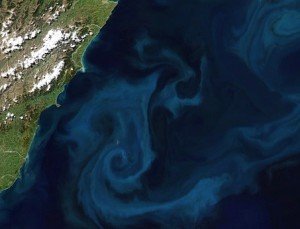Global stocks of phytoplankton — the foundation of the marine food web, and drivers of the ‘biological pump’ that sequesters carbon in the deep ocean — have been falling for last hundred years, according to a study published today in the journal Nature.

The study suggests phytoplankton have declined by nearly 40 per cent since mid-century, most probably due to rising sea surface temperatures and changing ocean conditions. The research team combined modern satellite data with decades of historical shipboard records measuring underwater visibility (which decreases with higher concentrations of phytoplankton).
Boris Worm, marine biologist at Dalhousie University in Halifax and one of the paper’s authors, says that reduced phytoplankton growth adds a extra dimension – on par with ocean acidification, coral bleaching and overfishing – to the issues of climate and human activity-induced change faced by the marine environment.
Click here for links to global news coverage of this story.
Dr Philip Boyd, National Institute for Water and Atmospheric Research (NIWA) Centre for Chemical & Physical Oceanography, University of Otago comments:
“This is the most detailed study to date, over the longest time period, on whether phytoplankton stocks are declining. As phytoplankton underpin the productivity of most marine ecosystems in our exclusive economic zone (EEZ), regionally and globally, the projected progressive decrease in stocks would have major and growing ramifications for the stocks of both farmed shellfish and wild fisheries.
“The regional analysis and comparison with indices of climate variability (such as El Nino) are perhaps the most valuable and compelling aspect of this study, and highlight how a changing climate will probably alter ocean productivity.
“However, although the authors provide compelling evidence – from meticulous statistical analysis – of a decline in stocks, at both a global and regional scale, over this period the annual changes they compute are small (1% of the global median). Also it must be borne in mind that chlorophyll is not a direct measure of phytoplankton stocks but an indirect one (a so-called proxy), and hence trends based on small annual changes in the concentration of a proxy must be treated with caution.”